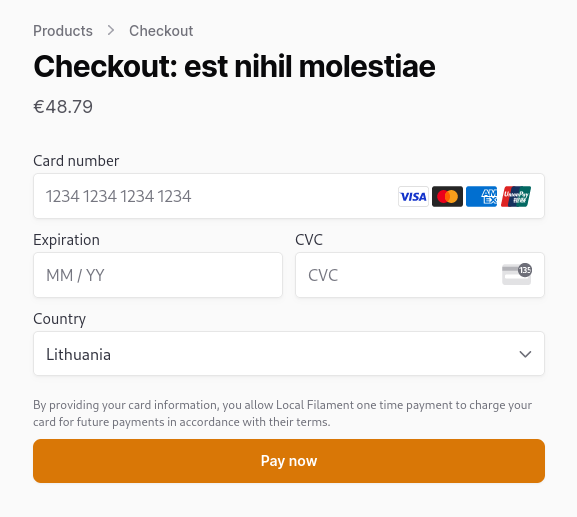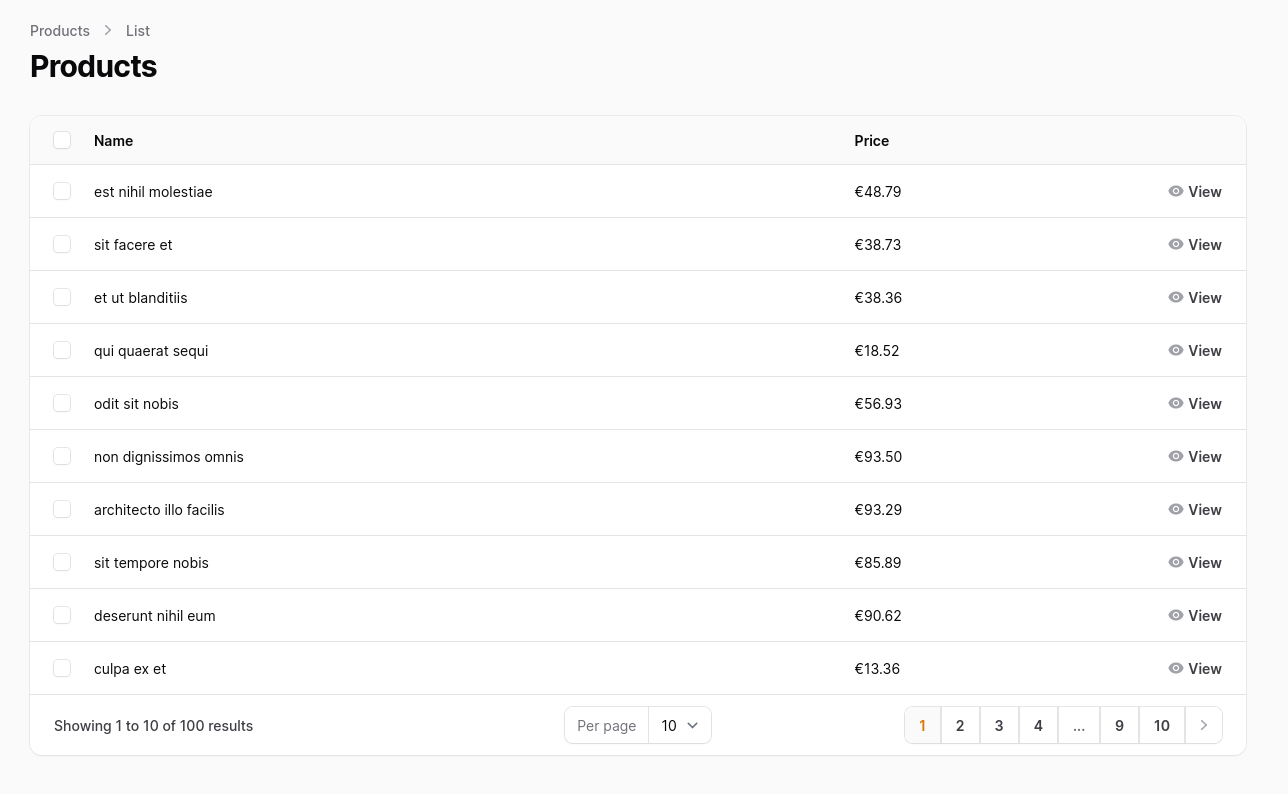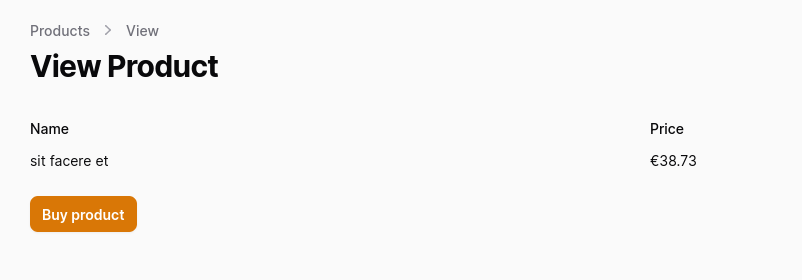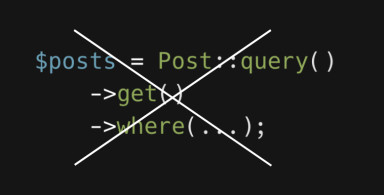Filament is great for admin panels, but what if you want to use it as an e-shop with payments? In this tutorial, we will show how to integrate Stripe one-time checkout into Filament.

Prepare for quite a long "ride" because there's a lot of work to implement it properly, with all the JS/PHP/Livewire elements, validation, and webhooks.
Table of Contents
- Data Preparation: Models/Migrations/Factories
- Filament Product Resource
- Custom Filament Pages: Checkout and Payment Status
- Back-end: Stripe PHP Library and Payment Intent
- Checkout Page: Stripe.js, Form and Stripe Elements
- Handle the Submit Event
- Show Payment Status
- Post-payment Events: Order Approval and Webhooks
Ready? Let's dive in!
1. Data Preparation
Our goals in this section:
- Create Product and Order Model
- Add relationships
- Populate
productstable - Create a
ProductResourcelist and view pages - Add the Buy product to view page
That is how our final pages should look like.


1.1. Migrations, Factories and Models
First, let's create Models; only the Product will have a factory.
php artisan make:model Product -mfphp artisan make:model Order -mThen, update the migrations.
database/migrations/XXXXXX_create_products_table.php
Schema::create('products', function (Blueprint $table) { $table->id(); $table->string('name'); $table->bigInteger('price'); $table->timestamps();});database/migrations/XXXXXX_create_orders_table.php
use App\Models\Product;use App\Models\User; // ... Schema::create('orders', function (Blueprint $table) { $table->id(); $table->foreignIdFor(Product::class); $table->foreignIdFor(User::class); $table->bigInteger('amount'); $table->timestamps();});In ProductFactory, we define column data. Notice that we store the price in cents.
database/factories/ProductFactory.php
public function definition(): array{ return [ 'name' => fake()->words(3, asText: true), 'price' => rand(999, 9999), ];}app/Models/User.php
use Illuminate\Database\Eloquent\Relations\HasMany; // ... public function orders(): HasMany{ return $this->hasMany(Order::class);}And then add relationships into Models.
app/Models/Product.php
use Illuminate\Database\Eloquent\Relations\HasMany; // ... public function orders(): HasMany{ return $this->hasMany(Order::class);}app/Models/Order.php
use Illuminate\Database\Eloquent\Relations\BelongsTo; // ... protected $fillable = [ 'product_id', 'user_id', 'amount',]; public function product(): BelongsTo{ return $this->belongsTo(Product::class);} public function user(): BelongsTo{ return $this->belongsTo(User::class);}1.2. Database Seeder
Now let's update DatabaseSeeder.
database/seeders/DatabaseSeeder.php
use App\Models\Product; use App\Models\User; public function run(): void{ User::factory()->create([ 'name' => 'Admin', 'email' => 'admin@admin.com', ]); Product::factory(100)->create();}And seed the database.
php artisan migrate:fresh --seed2. Filament Product Resource
Generate ProductResource and view pages using the Artisan command. Filament doesn't create a view page by default, so we must add the --view flag when creating a resource.
php artisan make:filament-resource Product --viewImplementation of the resource file:
app/Filament/Resources/ProductResource.php
namespace App\Filament\Resources; use App\Filament\Resources\ProductResource\Pages;use App\Models\Product;use Filament\Infolists\Components\Actions;use Filament\Infolists\Components\Actions\Action;use Filament\Infolists\Components\TextEntry;use Filament\Infolists\Infolist;use Filament\Resources\Resource;use Filament\Tables;use Filament\Tables\Columns\TextColumn;use Filament\Tables\Table;use NumberFormatter; class ProductResource extends Resource{ protected static ?string $model = Product::class; protected static ?string $navigationIcon = 'heroicon-o-rectangle-stack'; public static function infolist(Infolist $infolist): Infolist { return $infolist ->schema([ TextEntry::make('name'), TextEntry::make('price') ->formatStateUsing(function ($state) { $formatter = new NumberFormatter(app()->getLocale(), NumberFormatter::CURRENCY); return $formatter->formatCurrency($state / 100, 'eur'); }), Actions::make([ Action::make('Buy product') ->url('/'), ]), ]); } public static function table(Table $table): Table { return $table ->columns([ TextColumn::make('name'), TextColumn::make('price') ->formatStateUsing(function ($state) { $formatter = new NumberFormatter(app()->getLocale(), NumberFormatter::CURRENCY); return $formatter->formatCurrency($state / 100, 'eur'); }), ]) ->actions([ Tables\Actions\ViewAction::make(), ]) ->bulkActions([ Tables\Actions\BulkActionGroup::make([ Tables\Actions\DeleteBulkAction::make(), ]), ]); } public static function getPages(): array { return [ 'index' => Pages\ListProducts::route('/'), 'view' => Pages\ViewProduct::route('/{record}'), ]; }}Filament's infolists can use...
-front_grid.jpg)
-front_grid.jpg)

-=-{-axios.get('apiabilities')-.then(response-=-{-front_grid.jpg)
-front_grid.jpg)
;-(22)-front_grid.jpg)